#game critique
Text
Has Genshin Impact lost its way with narrative character designs? Critique and Praise
I like simple yet unique and memorable visuals in storytelling. I think this goes for my taste in any form of visual art: graphic design, video editing, illustration…
Has Genshin Impact lost its way with narrative character designs?
The outfits keep on getting more and more detailed and complicated with each character but I don’t feel much looking at them. From Inazuma onwards, at a glance, it all just seem like just another sparkly anime character design (especially for the female characters) instead of something unique that conveys the character’s personality to me.

Are the designers at HoYoverse too focused on making them marketable in a Gacha game rather than making sure their designs convey their personality effectively? Are they aiming for more and more complex character designs while forgetting the aesthetics, themes, and storyline that ties them all together for each region?
This is another reason why I lost my interest significantly after Inazuma’s release.


For this reason I personally feel Albedo, Barbara, Diluc, Rosaria, and Venti have some of the most memorable character designs amongst the Mondstadt cast, dare I say even amongst all the playable characters released. (Of course it’s also influenced by my personal tastes in character designs.)
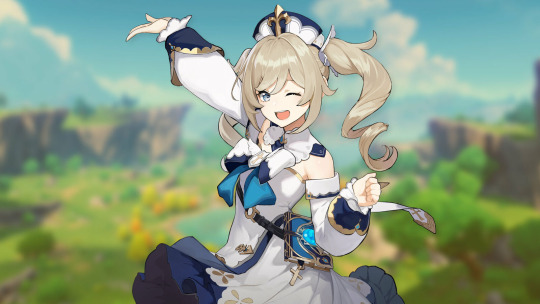
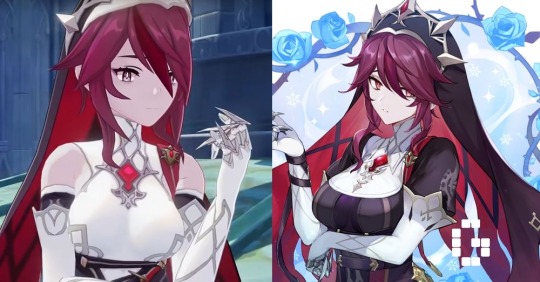
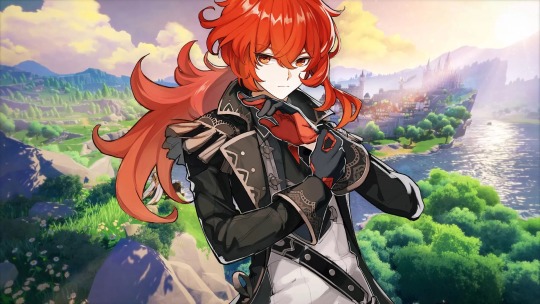
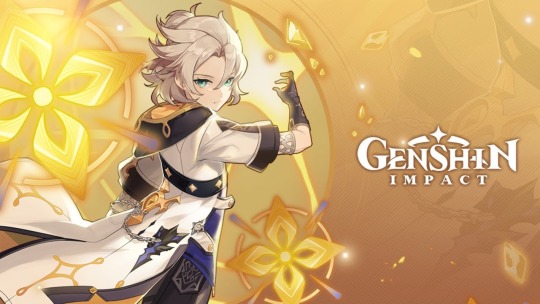
They’re simple and not very flashy, so attention goes to their face, which is where you should be looking at first in a character design most of the time.
The use of black and white in them (or navy and white for Barbara) only brings out their face and defining assesories plus key colours even more. Their clothes are not outstanding with the muted colours. Blue, magenta, red, and gold are the respective “character colours” that pop out for Barbara, Rosaria, Diluc, and Albedo. Blue for gentleness and kindness, magenta for aloofness and mystery, red for resolve and individuality, and gold for elegance and perhaps prestige. These are all first impressions one might have towards them.

As for Venti, his colour palette is very pleasing and it’s obvious that green is the main colour with shades of beige, white, and gold being details. Pops of cyan in his eyes and “Vision” cools down the design and makes it look refreshing. His colours are in the mid-range in value, so giving him dark navy hair draws attention to his face immediately. A good design for a carefree wind god. You look at him, and he seems like just a little boy, if not somewhat androgynous.
I miss the Mondstadt times, where the storyline is simple enough that the characters feel familiar and welcoming.
#dusk analysis#Genshin impact#charater design#analysis#anime character design#character design analysis#design analysis#Diluc#Barbara#albedo#Rosaria#diluc ragnvindr#albedo kreideprinz#barbara pegg#Liyue#Mondtadt#Inazuma#game critique
72 notes
·
View notes
Text
Halo 5: Guardians - A Game I Love
youtube
It's the one I've been Waiting for/ Dreading.
#halo#youtube#video essay#game criticism#game critique#master chief#john 117#halo 5#halo 5 guardians#spartan locke#edward buck#holly tanaka#olympia vale#Youtube
1 note
·
View note
Text
Pokemon Yellow, Furries, and Interactive Cuteness
Cute is powerful. Commercially and critically, cuteness has garnered incalculable success in today’s consumerist Western society. This extends to various franchises and media, from animated film to video games. One such franchise which utilises the power of cute through its multimedia empire is Pokémon, a worldwide success which is currently the highest-grossing media franchise of all time (“Top Media Franchises”). To achieve this lofty height, Pokémon has been reliant on the aesthetics of cuteness in all its media. This essay will look at the impact of interactivity on the appeal of cuteness, prodding at how Pokémon’s success is borne through a combination of cuteness and interactivity with cute objects which inspire “emotional attachments to imaginary creations” (Allison 382). As such, this essay will focus specifically on the video games arm of the Pokémon franchise. I first wish to discuss the design philosophies which spawned the close relationship the game medium has had with cuteness since its inception. Early computer systems were too limited to produce detailed graphics, which meant relying on abstraction. Cute, however, is often simple, making it a viable principle to design game characters around. This inherent tie between video games and cuteness naturally led to a taste in game players for cute characters, one which has persisted to this day despite technological advancements allowing for photorealistic graphics. Secondly, narrowing the lens to purely the Pokémon video games, this essay will examine Pokémon’s personal relationship with cuteness and the impact of its interactivity. Through hours of play and dozens of different titles spanning over three decades, the game series is designed to evoke a sense of longing and care for the Pokémon creatures that players catch and bond with through the games. Pokémon Yellow Version will be used as a case study for the various game design innovations which developers Game Freak made to enhance the game’s cuteness, and therefore add to the relationship between player and character. This included having Pikachu follow players outside of battles and react to various story events. Lastly, I will discuss the Pokémon franchise through the context of the furry fandom, a large worldwide group of people who craft their identities around anthropomorphic animals (which include Pokémon). Furries mimic and recreate Pokémon characters in real life, often creating OCs, or original characters, which represent themselves through the cuteness of Pokémon designs. Cuteness becomes identity; a vision of oneself which through years of interaction and bonding inspires people to spend thousands on costumes to briefly become those self-same cute monsters.
Despite its relative modernity compared to other media, video games have evolved substantially across the past five decades of their prevalence. Technology has allowed games to create entire 3D worlds that are inhabitable in virtual reality, yet the origin of the artform stems from basic lines and pixels on a 2D plane. The limitations of early games in the 70s and 80s created a symbiosis with the ‘cute’, a necessary marriage birthed from the need to represent characters with such little power to render detail. The consequences of these limitations led to the birth of many different memorable gaming characters: Mario, Kirby, Sonic, Pacman etc. The general connective tissue with these characters is their art style. Derived from the ‘chibi’ aesthetic that was popular in manga at the time, these Japanese created games all featured characters with features often cited as “essential” to the creation of a cute character. Take Kirby, a pink circle with eyes (fig 1). The properties of Kirby’s design are derived from the limited canvas video games offered, which also happen to mesh with the design principles that make designs cute – “round, without bodily appendages, (…) non-sexual, mute” (Cheok 298). The list expands beyond this, yet most traits associated with cuteness are also fundamentally simple, which makes them easier to render for low-tech hardware. With Kirby, the intent was clearly to make a cute character, yet this principle applies to characters that aren’t necessarily meant to be cute. Pacman is just a moving pie-chart in the arcade game, a vehicle for the game’s mechanics. However, this necessity to make Pacman look like he’s eating using so few pixels also happened to be a perfect companion to making a marketable, cute mascot. By using cute character designs, developers can create characters that are easy to render and memorable, while publishers are able to market games through their appeal as cute objects – both in advertising for the games themselves as well as merchandising. This relationship was spawned exceptionally early in the lifespan of video games as a form of commercial media, and that ensures a consumer market that associates video games, at least partially, with the aesthetics and tastes of cuteness.
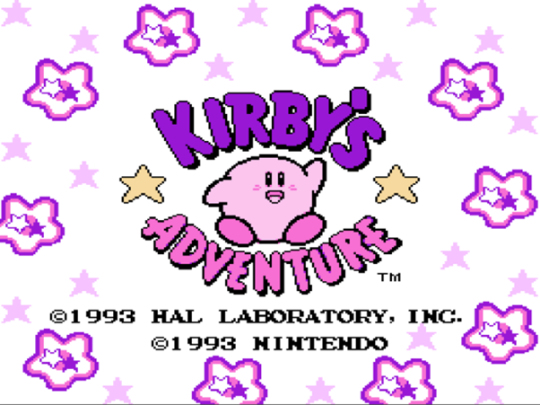
Taste in video games and in the cute, then, have been nurtured concurrently in consumers. To speak of taste is to speak of many systems which effect the enjoyment of a vast array of subjective activities and media. It is a vast subject, one which can only be touched upon in a limited capacity here, yet I think it is important to discuss what taste in video games and taste in cute says about the medium and its consumers. Hennion describes tastes as being “lived by each but fashioned by all, (…) a history of oneself permanently remade together with others.” (103). This description is pointed in its assertion that taste creation is a collaborative, social enigma. Tastes are ever shifting with the tide of a wider society, through media and through friendships. One can receive a taste for something or give that taste to someone else. Taste inherently becomes a tool of influence, a way to define a person and change those definitions over time and over different experiences. This makes taste incredibly powerful in a capitalist society that is fuelled on the ability to sell anything and everything to a consumer. New technologies and media, such as video games, are perfect vehicles to create more consumers by giving them a taste for something new, something expensive, something profitable. Cuteness, in this regard, then becomes the tool by which video games can achieve mass appeal – a way to paint over the foreboding and intimidating technologies which produce the games we play. Focussing on Japan, the region most closely associated with cuteness and technology’s intermingling, it’s hard to ignore that “many cultural transformations in Japan are essentially obsessed with technology” (296). This includes traditional video games, such as Mario, and gadgets and devices such as the Tamagotchi that fall somewhere between traditional toys and video games. These devices transformed consumer cultures in Japan, and their relationship with cuteness assured that cute sensibilities were ‘in taste’, popular and ever-present. The cute or “Kawaii” is irrevocably associated with “the technological landscape of Japan” (Cheok 298). I would argue that through the influence and popularity of games, the world outside of Japan also associates the cute with technology, if less severely. Pokémon is the perfect example of this.
Appearing in the late 90s, Pokémon made a clear impression on the gaming market. Quickly becoming an astronomical success, it was impossible to avoid the multimedia deluge of Pikachu laden content that graced both the West and Japan. The games are about collecting and fighting a multitude of Pokémon creatures, 151 in its initial release, through a role-playing adventure across a world inspired by the Kanto region of Japan. It follows a basic RPG formula of a grand adventure spanning tens of hours, all the while your characters gain experience and grow stronger through the course of the journey. Uniquely compared to other popular RPG franchises like Final Fantasy, however, is the fact that Pokémon is set in an urban setting not dissimilar to the modern world we live in. Characters in the game have televisions, while large shopping centres and gambling parlours are found in the region’s bigger cities. It is a modern world infused with Pokémon creatures. By making the world of Pokémon so closely fit our own, players can better relate to the events of the game and imagine our own world filled with cute creatures that roam around. It makes it easy to imagine interacting with Pokémon. “Bringing these characters out of the screen, so to speak, triggers the fantasy of enveloping them into everyday life” (Allison 385), and such, the marketing machine would pump out endless supplies of merchandise specifically to sell these cute creatures to consumers who had played the games and become attached to their Pokémon. How could they not when the game design is so catered to making sure players build an intimate relationship with their Pokémon? The game opens with a choice between three Pokémon to be the player’s first. The player is shown a portrait of the potential choices and can therefore make an instant connection with them based on their cute appearance. Given the game only lets you take six Pokémon with you at any given time, and that the starter Pokémon you choose is designed to be one of the strongest, it is likely that the player will keep this Pokémon in their team for the whole game. Growing with them, leading them to victory or defeat, hearing their cries of pain or success. This ability to influence these creatures, interact and play with them, enhances the relationship between video game character and player. “Cuteness here involves not only interaction with a virtual creature, but also its creation and maintenance.” says Anne Allison, and in maintaining this creature, they gain “pocket intimacy”, a “portable companion with whom they can interact with where they go” (391). It is the mingling between cuteness and the interactivity of video games that makes this possible, and I would extend Allison’s idea to its logical conclusion: this interaction with cuteness leads to a desire for people to take the Pokémon out of the game, and into their physical world through the purchase of merchandise.
Many of Pokémon’s most effective ties between cuteness and interactivity were present since the first trio of games were published, yet Nintendo never stopped adding more cute creatures or ways to bond with them virtually. Over the past three decades, Pokémon has released dozens of games across eight generations, a term used to describe when the franchise adds a new set of Pokémon to the roster – we are close to reaching over one thousand. The second game in the series, an add-on to the original trio based on more heavily on the wildly popular anime series that was releasing at the time, was Pokémon Yellow Version. Still in the first generation, this game made clear the direction of the franchise and its commitment to enhancing the bond between player and merchandisable product. The most immediate change was to the branding – while the original games featured a choice between three starter Pokémon, this version would only allow players to start with the eponymous Pikachu, just as in the anime TV show. Players are immediately met with Pikachu’s visage from the box art to the title screen (fig 2). The Yellow Version in the games title obviously referring to Pikachu’s immense surge in prominence. The cute mascot of the wider Pokémon universe had made its mark on the games and would come to define the entire experience. As a mascot, “Pikachu was chosen for a number of reasons: its bright yellow color, memorable chant (…), unforgettable shape, and, most importantly, its cuteness which could attract just about anyone.” (Allison 385). These aspects of the character were defined in concept art and the anime, yet not apparent in the original games, which used a far pudgier version of Pikachu (fig 3) compared to the sleek design used in later media (fig 4). Pikachu’s power of cute would tie with Yellow Version’s new game mechanics to create an experience that gave personality to Pokémon creatures. Pikachu would now follow the player in the world of the game, rather than being contained in a Pokéball like all other Pokémon. This would allow players to always see Pikachu, not just in battle, and feel the intense sting when a poor choice results in them being incapacitated and disappear from the game screen. Pikachu even reacts to story events, making varied cries and noises voiced by Ikue Ōtani, their voice actress in the anime (all other Pokémon use synthesised cries). One can talk to Pikachu to see how they are feeling, and they’ll react with a variety of different animations (fig 5). The ability for the player to interact more closely with their Pokémon further sells them as companions to bond with instead of tools to win battles and complete the game with, and it is their cuteness which allows this intense bond.
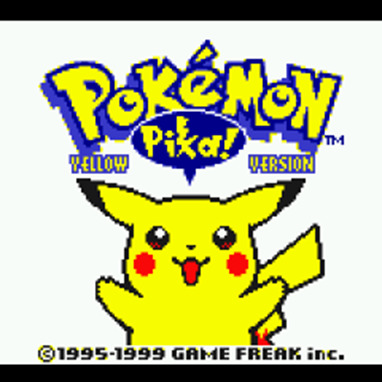

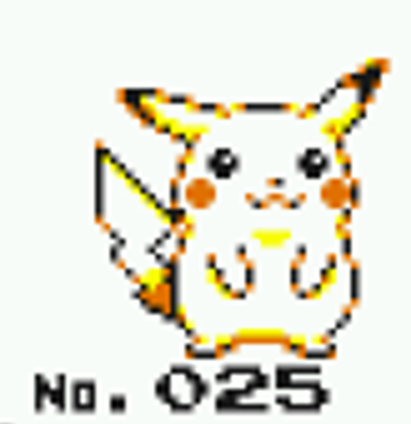

Pokémon was a smash hit, in no small part due to the marketable power of cute anthropomorphic animals. The choice to use animals as a basis for the design of most Pokémon makes sense, given that animals in the real world are both cute and ferocious – necessary features when creating a game about fighting and raising creatures. The appearance of many of these Pokémon would mimic the design sensibilities of kemono, a Japanese concept which merges human features with animals. This is generally comparable to the concept of furries in the West, a widespread fan culture based around the creation of anthropomorphic artwork. Pokémon such as Lucario (fig 6) or Zeraora (fig 7) are extremely popular within the fandom due to their clear anthropomorphic design sensibilities. While Pokémon does not market directly to the furry fandom (the demographic, despite consisting of millions, is neither mainstream nor respected), these designs do inspire an amount of fan creativity and relatability that goes beyond what the games can offer independently. Essentially, furries take the idea of Pokémon, of being able to play with and bond with different cute creations, to the real world by crafting fursuits and fursonas based on these popular designs. Furry as a sub-culture is engaged with “fairly idiosyncratic fandom-related interests: they construct fursonas – anthropomorphic animal-themed identities to represent themselves.” (Reysen 1). As such, by creating fursonas that are based on Pokémon, furries mesh their constructed identities with what they perceive these Pokémon designs represent. Oft times, this is forged from a desire to become these cute creations, if only for entertainment and recreational purposes. It is an extension to the desire to own “iconized (…) commercial goods” which Pokémon appear on, such as “T-shirts, bookbags, calendars” (Allison 387) etc. The purchase of these products stems from a desire to bring Pokémon creatures into the real world – furries conclude that line of thinking. As such, intricate and expensive fursuits are created of these designs (fig 8 & 9) that allow furries to play as their favourite cute Pokémon in the real world. This extreme length to deepen the bond between player and product reminds me of Annemarie Mol’s musings on taste in food, where she states, “tasting cannot be done from a safe distance, it requires bodies quite literally to mix with this rest of the world.” (279). I would argue the intimacy of tasting here, the requirement of vulnerability, of openness to mix with others, is quite apt in describing the eagerness with which furries bring the world of Pokémon into the real and allow their cuteness to inspire them creatively.

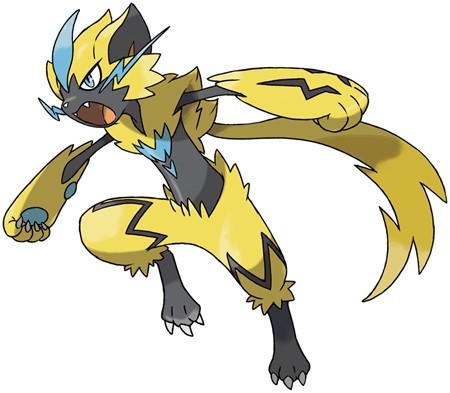


The emergence of Pokémon within the furry fandom throughout the 2000s has been enormous, and this is interesting as fursonas are often representations of a person’s identity. By creating this personal identity around a marketable and copyrighted design, the case study brings up some concerning questions around the power of capitalism and consumerism in controlling a consumer’s ‘ideal’. Fursonas are “alternate identities” (Reysen 1) and are often constructed as “psychologically or behaviourally similar” to the person, essentially an “idealised version of themselves” (6). Through effective design, these Pokémon designs have become a part of certain furries’ ideals, which demonstrates the power of cute to impact the tastes and personalities of people around the world. I hesitate, however, to deride this morally – many capitalist products are personally impactful to all manner of people and become part of their identity (favourite films etc). It is important to keep in mind that the most integral part of the furry experience is the ability to self-curate personality and aesthetic traits into an alternate self. Pokémon creatures are therefore used as a base to build upon; add personal flair to. Cuteness is the ideal in itself; Pokémon is the vehicle by which people can attain it.
Virtual cuteness is ever-present in today’s consumerist society. From the early beginnings of video games as a commercial medium, technological restrictions on the creation of games have assured a clear connection between the aesthetics of cuteness and video games. Early gaming devices did not have the ability to render graphics with high fidelity, meaning games would rely on simplistic graphics which naturally mesh with the principles of cuteness. Cute is often simple, as seen in designs like Kirby. This early connection between cute and technology meant that the taste for video games was tied with a taste for cuteness in players. “Consumption is speedy, and the threshold of boredom is a slender line, each Kawaii character battles for supremacy and then survival.” (Cheok 299). Hence, the success of franchises like Pokémon relies on the “supremacy” of their cute mascots. Pokémon games are a perfect combination of cuteness and interactivity. They take the traditional principles of RPG video games and transcribe them into a modern day setting with cute creatures around every corner. Players grow and bond with their Pokémon, both through success and failure, through tens of hours. Pokémon Yellow Version demonstrates some of the evolution of the Pokémon franchise, showing a further reliance on the cuteness of Pikachu as a mascot and a design focussed on bonding with a character with a clear personality. Lastly, I have discussed here the impact of Pokémon and cuteness on the furry fandom, a group of people who craft alternate identities through donning the appearance of anthropomorphic animals. Furries recreate Pokémon in the real world through custom fursuits. This brings Pokémon closer to the real world and demonstrates the impact of cuteness in pop culture on groups of people. Pokémon, and their cuteness, allow people to adopt their designs as a base for imprinting their own ideal identities onto. The taste for cute, driven to the masses by the vehicle of a multi-billion dollar franchise.
Works Cited
Allison, Anne. “Portable Monsters and Commodity Cuteness: Pokémon as Japan’s New Global Power.” Postcolonial Studies, vol. 6, no. 3, Taylor & Francis Ltd, 2003, pp. 381–95.
Cheok, Adrian David, and Owen Noel Newton Fernando. “Kawaii/Cute Interactive Media.” Universal Access in the Information Society, vol. 11, no. 3, Springer-Verlag, 2011, pp. 295–309.
Guttmann, A. “Top Media Franchises by Revenue 2021”. Statista, 18 Aug. 2021, https://www.statista.com/statistics/1257650/media-franchises-revenue/
Hennion, Antoine. “Those Things That Hold Us Together: Taste and Sociology.” Cultural Sociology, vol. 1, no. 1, Sage Publications, 2007, pp. 97–114.
Kirby Sprite. Retrogamer, https://www.retrogamer.net/retro_games90/kirbys-adventure/
Lucario Official Artwork. Pokemondb, https://pokemondb.net/pokedex/lucario
Mol, Annemarie. “GOOD TASTE: The Embodied Normativity of the Consumer-Citizen.” Journal of Cultural Economy, vol. 2, no. 3, Taylor & Francis Group, 2009, pp. 269–83.
Pokemon Blue Version. Gameboy Version, Nintendo, 1997.
Pokemon Yellow Version: Special Pikachu Edition. Gameboy Version, Nintendo, 1999.
PriamWolf. “Lucario Fursuit.” Furaffinity, 2017. https://www.furaffinity.net/view/20139678/
Reysen, Stephen, et al. “My Animal Self: The Importance of Preserving Fantasy-Themed Identity Uniqueness.” Identity (Mahwah, N.J.), vol. 20, no. 1, 2020, pp. 1–8.
Willowcookie. “Zeraora Full Testfit.” Furaffinity, 2018. https://www.furaffinity.net/view/26076982/
Zeraora Official Artwork. Pokemondb, https://pokemondb.net/pokedex/zeraora
#pokemon#cuteness#cute#furry#anthro#game critique#games#video games#nintendo#essay#analysis#game design
3 notes
·
View notes
Text
Hozier visited my college and held a competition which I won, the prize was that I got to play Wii Sports Resort while he critiqued me.
1K notes
·
View notes
Text

An absolutely killer quite from Harper Jay in this article from Aftermath.
555 notes
·
View notes
Text
Cannot stop thinking about thresh and reaper in the hunger games movie. Two black boys who are shown to really strong and could easily take out the other tributes. And how they're precieved as violent because of it.
But when they enter the arena they're seen as the exact opposite. The only death that we see thresh take on screen is clove bc she kept bragging about rue's death. Which we can tell hurt him bc if you look at scenes before the games he seems to be protective of her. And he could have easily killed katniss but he spares her life because katniss humanized rue.
And with reaper. We're told that he killed a peacekeeper in his district and he threatens snow but in the arena its shown that the only thing he cares about is protecting dill. He even defends her from attackers in the beginning and tells her to stick by his side.
And I cannot stop thinking about rue's death. And how although it is violent (a spear through her body) it's not shown in a grotesque way (I don't think we even see blood when she pulls it out). And with dill it's a similar situation. A girl with tuberculosis who drinks water that she doesn't know is filled with rat poison. And when she drinks it she doesn't convulse or do anything dramatic she just lays down and dies.
And I can't stop thinking about how those deaths are instantly humanized. Katniss and reaper both scream in anger when they find out about it. They cry about it. And then they instantly mourn her. Katniss stays with rue until the end and sings with her until she passes and then gathers flowers to give her a proper burial. And it's the same with dill. Reaper grabs her body (and the other tributes and removes their weapons) and he covers them with the flag of the capitol. To show that they're the cause of tributes deaths.
And then katniss and reaper bodly faces the camera and expresses disdain for what's going on. Katniss raises the 3 finger salute and reaper screams "are you gonna punish me now??"
And I cannot stop thinking about how when thresh dies you don't see any of it you just hear screams. And when marcus is in the arena he is tied up and beaten and shown as an example bc he ran away and he could have easily died a violent death from the other tributes. But he is given a mercy killing by another tribute. And when Jessup dies. It's because he has rabies from protecting Lucy gray from the bats on the train. But he also dies in a non violent way bc he was given water to scare him away and he just ends up accidently falling. And how when reaper dies its him being engulfed in snakes because he finally accepted his fate.
And idk this probably doesn't make sense bc it's currently 4am in the morning but as a Black fan I am glad that in a world where my people are constantly dehumanized and our graphic deaths are released in video format for the world to see and be desentized too....
It's nice to not see anything violent and dehumanizing about us in a series about kids dying to the death. Like everyone knows that the black kids are gonna die but they could have done something really violent with them and it's nice to not see that happen.
#the hunger games#tbosas#the ballad of songbirds and snakes#reaper ash#thresh#rue#jessup diggs#marcus#dill#hush ke#my only critique is the colorism in rue and dill casting but that's a topic for another time
567 notes
·
View notes
Text
for all its (apparently many?) flaws, i really enjoyed the fallout show, and i'm ride or die for maximus, obviously. but one of the things i enjoyed about lucy's arc isn't that she wasn't necessarily proved RIGHT or WRONG about her own moral code, she didn't learn that either kindness is its own reward or that niceness is suicidal in a fight for survival.
what she learned, i am pretty sure, is that context matters. you can't actually help people if you don't know anything about them. you can't enact justice if you don't know what the case on trial is. you can't come in out of nowhere and make snap decisions and be anything more than one more complication in a situation that was fucked up long before you were born.
that's what we see over and over: she comes in out of nowhere, she makes an attempt to help based on her immediate assumption of what's going on, and then everything continues to be dangerous and complicated and fucked up. she doesn't let the stoners explain that some ghouls will genuinely try to eat you the minute they get the chance, and she pays for it. she jumps to the wrong conclusion in vault 4 because not everyone who looks like a monster IS a monster, and she pays for it. yeah a lot of the time cooper is abusing her for his own satisfaction, but when she's a free agent she's a loose canon and it's not because the show is punishing her for TRYING to do the right thing. it's because the show is punishing her for jumping to conclusions.
this show gets a lot of laughs from Fish Out Of Water situations, but i think that even though cooper explicitly says "you'll change up here and not for the better, you'll become corrupted and selfish just to survive" that's not the real message. what lucy learns is how important it is to hear people out, meet them where they're at, and get the full story.
that's why the final confrontation with her father is so important. she hears everyone out. she gets the full story. she listens to all of it. and then she acts with full knowledge of situation. that's what the wasteland taught her: not to be cruel, not to be selfish, but that taking the time to understand what's actually going on really matters.
this is a show that's incredibly concerned with truth and lies. everyone is lying to each other and themselves. scenes change over and over as they're recontextualized. love and hate and grief and hope are just motives in a million interconnected shell games, not redeeming justifications. maximus's many compounded falsehoods are approved of by his own superior, who finds a corrupt pawn more useful than an honorable one. cooper finds out his wife has her own private agenda and this betrayal keeps him going for centuries. lucy's entire society is artificial and from the moment they find out they're not safe and maybe never have been, all the vault dwellers are scrambling to deal with that.
ANYWAY. i just think it's neat. sci fi is a lens to analyze our present through a hypothetical future, and i think it's pretty significant for this current age we live in, where we're all grappling with misinformation, conspiracy theories, propaganda, and deepfakes, there's a huge anxiety over how hard it can be to find the truth out about anything. i think the show suggests that it's always worth the work to try.
#fallout#ive seen critiques that it's fascist and reactionary and i can't speak to that#since i don't play the games#but for what i saw i liked it and thought it made some good points#spoilers
183 notes
·
View notes
Text
gonna get perhaps a little controversial for this site and say i think it's generally kind of a weird move to be proud of yourself simply for not liking something.
if you are boycotting a work for political reasons and it brings you some measure of peace or clarity to critique its messages, by all means go ahead; that isn't what i'm talking about.
but patting yourself on the back just for not deriving the happy chemicals from a potential source for them, in this world so full of pain and struggle, where sometimes it seems like we all have to fight to enjoy anything in the first place...why?
all of that said, i think i would care about the superbowl more if it had clearer dramatic stakes and better dialogue.
#and to be clear when i say dialogue i am not critiquing post-game press conferences or interviews with players or whatever#i am saying i want the players to be micced *during the game* and to say scripted one liners at dramatically important moments#and to be clear i would still not *love* it. but i would like it a little.#(wrestling. i am just describing wrestling.)#the important thing is i know these opinions are bad & dweeby! i would put fast-paced overwritten banter in every sport; i must be stopped#(but also: uh hey let's maybe do something about all those concussions huh??)
96 notes
·
View notes
Text
01/22/2023. 5:27 AM
A Personal Contemplation on Storytelling, Style, and Saturation in Genshin Impact
This isn’t goodbye, so let’s not call it that.
This is a revaluation.
.
I’ve been having thoughts about the game here and there at the back of my mind.
At times, I want to get away from Genshin Impact in pursuit of something new. Something that does storytelling on a more personal level. At other times, I come across some fan works that are more in line with my taste in themes and style, but since they’re derived from the game itself, I feel I “have to” play the game (or watch playthroughs) to understand them fully.
However, as someone who hasn’t yet done the third act of the Liyue Archon Quest, I feel “left behind” as the game constantly pushes out new content. Everything blurs together, and this over-saturation results in me the paradox of choice along with a feeling of distance between my experience and the newest releases, hence my hesitance in playing at all. If I go at my own pace—or rather, if I play the game based on what I truly want—I don’t actually feel very interested.
Why not quit? But here’s the paradox: I still want to explore some characters I like, and it doesn’t work well if I don’t know much about them. I still want to know about some characters I don’t know yet, but I’m almost afraid of how the execution of the story may fall beneath my expectations, as silly as it may sound. This ends up with me getting information about the characters by other means. I guess what I’m saying is that some fan works I’ve seen have, in my opinion, better storytelling than what I know of the game itself.
For example, for Shadows Amidst Snowstorms, I may have hyped myself up too much with how the storytelling might be based on aforementioned fan works. Perhaps it was because I made inferences and pieced together information myself. In storytelling, allowing the audience to make hypotheses instead of telling them everything makes it more interesting. On a fundamental level, for the aforementioned reasons, I guess the game’s style overall is not for me…?
At the same time, I know very little of the storyline nor characters from personal experience, so my opinion is naturally biased. I trust that the storyline and storytelling is getting better, especially with all the praise I hear of Sumeru’s Archon Quests. I watched Al Haitham’s character demo today, because I got it as an ad. It was nice and quite fresh that HoYoverse shows us other characters discussing a character through Kaveh, Cyno, and Tighnari socialising at the table. This, compared to Kaeya’s demo, or Zhongli’s demo, or Albedo’s demo, is more diverse in narrative and style.
But in truth, I lost interest by the time Inazuma was released, so I can’t even comment much on the Inazuma cast’s demo videos, much less on Sumeru.
It sounds like I’m complaining. I’m afraid of playing the game and I feel frustrated at how much I don’t know precisely because I hardly play the quests.
But hey, since this was written at 5 AM in the morning, take it with a grain of salt.
.
.
.
12 notes
·
View notes
Text
youtube
Yes... I did the phone games, and Annoyingly I think it's one of the best videos in the series so far
#halo#halo spartan assault#halo spartan strike#game criticism#video essay#youtube#game critique#sarah palmer#spartan assault#spartan strike#game retrospective#Youtube
0 notes
Note
2. What's your favorite and least favorite design in either show?
9. Since you mentioned drawing your redesigns, I have to ask - is there any way I could see Verity having a jolly ol' time on a swing? I was looking over your art again and the thought just struck me on impact out of nowhere.
13. Where does Lilith fit in Hellbound Hostel? Is there anything planned for her yet / concepts you're tossing around?

9. I know this probably isn't what you were imagining but!!! I love conversations on swings and I wanted to draw Eden and Verity together.
2. Favorite and least favorite designs are hard to figure out, most designs I like have glaring details I don't and designs I dislike have potential somewhere in the design. I'll pick the ones from Hazbin that I like/dislike the most as they are, speaking roles only.


Carmilla Carmine is my least favorite design. Her hair completely throws her design off balance imo. I hate the fact none of these characters have ears and I thought Carmilla’s earrings were dangling from her hair at one point. When her hair is down, her design is better I guess… but then there isn't anything that screams hell or sinner in her design. The hairstyle at least alludes to horns, without it she is just a grey human with red eyes and slightly big arms. I kind of wish she kept her extremely long fingers from the pilot, but that wouldn’t tie in well with her fighting style imo??? Eh.

Breaking my own rules since they never speak but, but this design ruins every scene it is in. What an attention grabbing eyesore, it was impossible to watch the overlord meeting with her just sitting on the side orz


Sir Pentious is probably my favorite design in the show, but the story behind his design just makes me sad. I don't like his tail and the eyes pasted all over it, slithering on your eyes?? ow. The hood acting like hair and flaring out is very enjoyable to watch. His palette is also more balanced than most characters. Prefer him without the hat though.
Breaking the rules again, my real favorites are background characters.


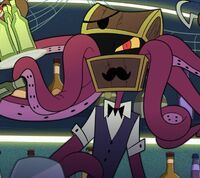

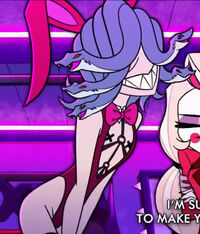

13. In Hellbound Hostel, Hellborn are created through a ritual that only requires one participant. Eden is more like a creation to [Lucifer] than a daughter and she has no mother. Sort of an [Adam] parallel. I might shift Lilith's role/traits to one of the Sins, Idolatry.
The Sins are effectively Eden’s family as they are all fallen angels that rebelled with [Lucifer]. A lot of the early/pilot stuff with Lilith shows her as wanting rebellion from sinners and I think Idolatry would also stoke that flame. She is a champion of individualism and finding your own “gods” to worship. She believes that the free will that humans were granted makes them superior to The Creator.
As for the aspect of someone from hell residing in heaven as a potential villain? I have some ideas but most of the conflict I’m figuring out right now is episodic conflicts centering around the hotel, like a power outage and trying to get residents excited for a hellborn holiday.
Thank you for asking! :D
#dys draws#dys rants#ask game#hazbin hotel redesign#hellbound hostel#hazbin critical#hazbin hotel critical#hazbin hotel rewrite#hazbin hotel criticism#hazbin hotel critique#charlie morningstar redesign#vaggie redesign#reblog
98 notes
·
View notes
Text
Putting the current angst aside for a second, I find it telling how the two major critiques to the game are that the characters are too nice to MC and that the ROs are too feminine (because they are nice. Because men aren't nice and don't say "dear" or "darling")
... I don't know
#over and over again on the itch comment section#which is a valid critique but also subjective#but i never like how it borders on sexism and how it implies a good story needs ROs who are not nice to mc even in harsh circumstances#sometimes i wonder how deep fantasy stories like got influenced the perception of politics in a fantasy world#i love a very angst complicated game of power every once in a while#but tkh was never intended to be like that#it's hurt comfort with the ROs providing the comfort (and not the hurt. for once.)#brief vent
215 notes
·
View notes
Text
Some things are meant to be remembered; for the right reasons.
i've posted this review on steam, but i think that i want to say it here, too.
Here is my review of the 'promotional' material (according to steam) Secrets of the Machine
What I liked: the art appeared to be a true return to form; the style had its original charm with updated lighting techniques and slightly better optimization than previous games in the Bendy series. The audio design was also nice, with good ambiance and nice composition.
And now, the jank.
The game handles reasonably well; but it is clearly slapdashed together and is missing important components.
There is no starting menu. There are no loading screens; and it is very jarring. There are no options in the game menu - you cannot minimize the game, you cannot brighten the game, you cannot make the game run any better on your computer, and it is incredibly laggy. If you have a potato laptop? Nah, get out. No game for you. There are no subtitles that you can enable, and voices are very muffled. Additionally, the game is very dark, and as mentioned, you cannot adjust that in the settings of the game, nor in steam settings. You have to do so from your computer.
Controls are extremely janky, as you cannot run, you cannot jump, and there is no indication for interaction with any objects. There are no control settings for remapping, and you cannot even see which keys do what.
Puzzles are boring and confusing; with no guidance. There were no hints, no rhyme or reason. There was more puzzle in the BATIM chapter 1 demo release. This thing is very confusing, especially when you cannot see anything at all. You will spend a long time walking back and forth between two rooms, wondering how you can progress, because you've done everything you could: you smashed cutouts; you hit targets; you opened and closed hands; you found posters for future games, but nothing that could move forward the one you were playing at the time. If you look at the community page, you will see that most people simply spent their time clicking on the soup can dispenser to see how many cans they could get.
If you have epilepsy, nah get out. Oh? I didn't mention the flashing lights? Well the developers did not either. Not only did they not mention the flashing lights, not in the game nor in steam, but they included TWO car crashes without warning - one audio based, and another that was directed at players. This is not only rude, but it is dangerous. Warnings exist so that people can make educated choices whether or not to interact with content that may be sensitive to them. Warn people appropriately. This 'game' did not take any measure to protect its players. There are many instances of sudden loud noises, flashing lights, and jarring location switches (not to mention the car crashes).
The story was lacking, and has nothing to do with the puzzles that a player is faced with. It feels like three disjointed tracks, and none of them align, all of them crashing together in a discordant, unsatisfying, confusing mess. It brought in more new characters that had nothing to do with the original story nor interested players, and had content that went against previously established material. It was (as you can tell, from a writer's perspective) a bad story.
It was less of a demo, less of a playable trailer, more like a tech demo with a few morsels for fans to pick apart and wish there was more of, wish there was more effort put into, wish there was more love and care for them, the players who arguably were the foundation of this game. There were teasers for games that, honestly, lacked the soul that the very first game had, and here's a point to prove it: there was an easter egg that if you clicked something 414 times (very funny.) it would rise in the air and then fall down without further ado. In the game files, the name for that sound effect? Sting. Yeah. It did. Games are a collaborative work; between the creators and the players. Blatant disregard and flippancy towards half of the collaboration is not acceptable behavior. This is a development team that mocks those who once loved them most, those who poured over their coding and carefully crafted world to marvel at what they had made, and coaxed in others with the rich promise of a delightful story that anyone could engage with on any level. The spite the creators have shown for the individuals who, essentially, had given rise to their stature in the first place, is painful.
Finally, by the time that I got a chance to sit down and actually play the game- I personally could not. The developers, by constantly updating a clearly unfinished game, had made their final update - that of a wood board blocking the actual place where gameplay takes place. You cannot go to any of the places shown in the screenshots, because the game is locked on the opening area. I've seen many people complaining of it; hoping that they can play the game.
Now, in the fashion we've seen common of JDS, they have rescinded their terrible design choice - but without notifying players that it is now possible to play the game; without telling players that this was purposeful; without telling players anything aside from a big old screw you. It is entirely possible that the only reason they put the game back into a playable state was the torrent of negative reviews that spawned after their. interesting. choice. regardless, those who care about their playerbase would have informed those who complained that it was a temporary gesture for storytelling reasons. They, however, did not, and there are a multitude of reviews marking the game as unplayable.
No matter what, the bottom line is this: This is not okay.
I'm not sure how much more eloquently I can put the fact that I'm heartbroken. This game, unlike any other, shows how much scorn that a developer can have for their own fans and playerbase. I am glad that there are people who enjoyed it, but I wonder - what did you really like about it?
Is it the memories?
#control critique#secrets of the machine#bendy#batim#bendy secrets of the machine#bendy and the ink machine#bsotm#bsotm review#game review
58 notes
·
View notes
Photo
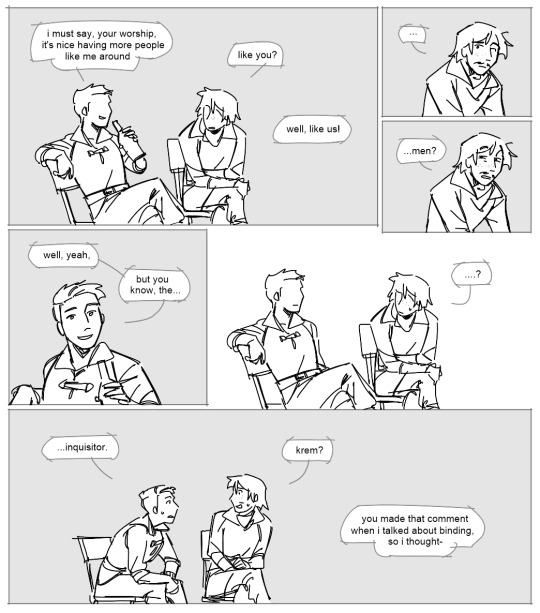
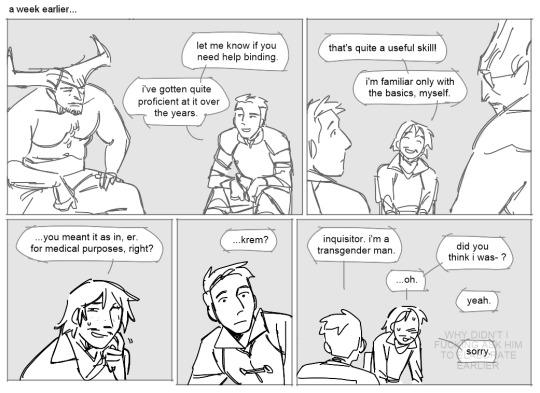
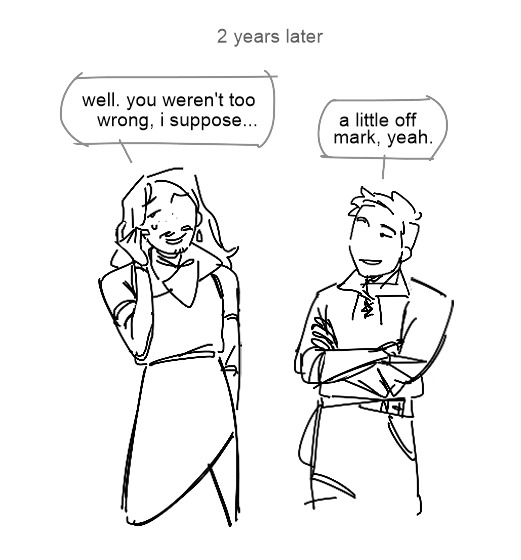
i’ve always found it peculiar how during meeting the chargers cutscene the game just assumes your character automatically understands what krem is talking about when he mentions binding (though, granted, it’s all very unsubtle). like, this is a roleplaying game. what if i want to play a character who just doesn’t get it
#dragon age#cremisius aclassi#inquisitor trevelyan#at least give me an in game explanation of why the inquisitor would Know this right away#it's not like transgenderism is a widely explored topic in da lore. the most you can find about it in inquisition specifically excluding#krem and seras countless transmisogynistic lines is one codex that mentions that some previous divine mightve been a trans woman#and the way it's written sucks ass. the infamous sex in thedas codex also mentions nothing on the topic of transness. so like#whats up with that#art stuff#before anyone says anything i fully realize how i look critiquing a bioware game that came out in 2014 on its faulty queer representation#please trust me i know. im just thinking out loud#ALSO. in case it isnt obvious. parsley transed they gender. the joke is that theyre a nonbinary femme now#its hard for me to show it through art because it would involve misgendering them but they dont actually start going by they/them pronouns#until after halamshiral. so like technically if i made them refer to themselves as he/him at any point before that it would be canonical but#its not like my art is chronological by any means and cannot be taken out of context by virtue of it existing as an individual post online#if someone were to reblog an art of them saying hi im a dude theyd go cool! hashtag male inquisitor. or something#the tragic case of sacrificing narrative in order to not get second hand discomfort at seeing parsley misgendered#ANYWAY..........
322 notes
·
View notes
Text
Listen you should absolutely recontextualize characters. The fact that Yosuke was completely reinterpreted as having a veritable battle of the somme going on inside himself with regards to his sexuality? Internalized homophobia that could only be described as life threatening? Excellent. Keep doing stuff like that. Do it to every damn character you find.
That being said, particularly after hitting up tumblr, I've seen a number of debates where someone is criticizing a character as they are presented in canon and someone argues tooth and nail against it and it is very apparent they are basing their opposition to the criticism on the version of a character that has been recontextualized in the fanspace.
Which I can understand evokes a lot of big feelings, particularly for people who kind of need these characters to be different for their own comfort. But I've been on the receiving end (not here yet) of fierce opposition for suggesting that Yosuke being a huge vehicle for gay panic jokes, and this is not considered a source of GENUINE conflict in game, reads as homophobic. People have then argued with me how this is wrong based entirely on arguments from the yosuke constricted by the fandom in the SouYo ship.
But I can't ignore that the Yosuke I was given on screen engages in rhetoric that is actually straight up mean-spirited at best and the root of violence at worst. And Atlus played it to me as a gag. And nothing more, JUST a gag.
#persona#persona 4#p4#yosuke hanamura#souyo#atlus games#jrpg#jrpg games#media critique#media criticism
159 notes
·
View notes
Text
i wanna go on a dumb rant. i’m supposed to be asleep rn but i need to share my thoughts
pony island (2016) is a better representation of hell and lucifer than hazbin hotel.
1. the sinners actually have a punishment. despite it being a silly thing like “working on a shitty mlp fan game.” it’s still a punishment. their memories and identities are stripped from them and some of the souls aren’t even that lucky. some of them are simply trapped inside the game with no one to hear their screams.
2. the devil actually acts like the devil. in hazbin hotel lucifer is just a blonde twink in a ringleader’s costume. he doesn’t seem to spend his time torturing souls or ordering his minions to do his bidding. he’s just making rubber ducks to be xd quirky. and yes while lucifer in pony island is kinda like this, i think it’s played better.
lucifer isn’t seen as a sad boy who was hurt by the angels. lucifer in pony island is a petty bitch who wants you to play his level 100 times and acts like you were in the wrong when you cheat to skip it. but he’s not just an asshole either, he’s still sympathetic in a way. he doesn’t care for torturing the souls anymore, be simply just wants to make his games in peace and to be praised.
anyways sorry for for this dumb rant about a video game nobody remembers and a shitty adult cartoon. i’m gonna go to bed now
#stupidwarriorkitties#pony island#mullinverse#daniel mullins games#hazbin hotel critical#hazbin hotel criticism#hazbin hotel critique#vivziepop critical
51 notes
·
View notes